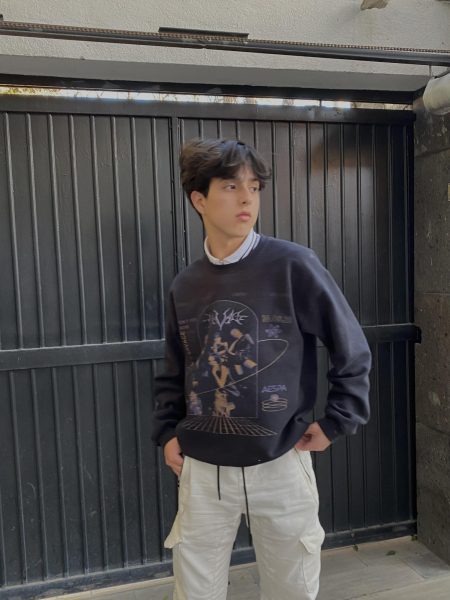On Oct. 31, Sabrina Carpenter released the music video for her viral carefree anthem, “Feather.” In the ironic video, inspired by early 2000’s horror films, Carpenter plays a girl all too comfortable murdering men who pay her uninvited sexual attention. However, what appalled many viewers was not necessarily the video’s depictions of murder, but rather its depictions of Catholicism.
The video, which has amassed over 20 million views and mostly positive reviews, features the actress and singer “mourning” her victims in a satirized altar inside Brooklyn’s Blessed Virgin Mary Church, wearing a short black tulle dress and veil.
Among the appalled was Brooklyn Bishop Robert Brennan, who believes the video to be profane and provocative, claiming a more in-depth investigation would be conducted regarding this issue.
“I can understand why the Church would respond in this way. To people that view the Church as a holy sanctuary, it would feel like a violation for them,” says AP Literature and Public Speaking teacher Robyn Samuelson, who has analyzed a number of religious texts throughout her academic career.
The investigation resulted in the dismissal of the pastor who allowed the crew to film at the church, Monsignor Jamie Gigantiello. The altar was then reconsecrated with holy water to repair the “damage caused” by the singer.
Carpenter joins a long line of musicians denounced by the church such as Lady Gaga, Madonna and recently Lil Nas X and Taylor Swift. Although, none of them developed their content on the premises of an actual church, which may set this video apart.
“Everything inside of a church has been consecrated or blessed by God, so I think it’s different than if she had used props, especially if you are of the mindset that all of these things are holy objects, and things that haven’t been inside the church aren’t consecrated and no longer have that spiritual value.” Samuelson expressed.
For Catholic Senior Katy Babcock, who also happens to be a Carpenter fan since childhood, the church’s agreement is enough to absolve the artist, who may not follow the Catholic doctrine, from allegations of sacrilege and disrespect.
“If the entity responsible for the affairs of that particular location agrees to allow the space to be for filming, that is on them,” explained Babcock. “This, of course, is more complex if the artist was not transparent with the property owner, which should be accounted for.”
Though not entirely transparent, the paperwork communicated by Carpenter’s team had clearly portrayed intentions of inappropriate behavior, according to Bishop Brennan’s investigation, which stated it was the Diocese that had mishandled their agreement. Additionally, Carpenter paid the church a sum of $5,000 for filming.
A “Pop-Up Video” was released on Dec. 5, where each of the music video’s scenes was accompanied by a pop-up box providing context on the editing and the artistic visions of both Carpenter and the up-and-coming director behind the music video, Mia Barnes. The new video explains the scene in the altar as a satirical funeral ceremony for “the boys who fought to death for her attention.”
“Artful criticism–creating an image that forces people to engage with some problematic thing that an institution or religion might be doing–is beneficial, when it is done for a moral point,” said Samuelson, though unsure of the video’s moral point.
Babcock believed the music video to be a significant contemporary critique. “People are distracted by her immodest and arguably offensive dress without seeing the clever commentary she makes by pairing men who objectify women with the Catholic Church. And I appreciate the light-hearted satire with which she presents that in the video,” said Babcock.
Mentioning the channeling of “feminine energy” and referring to the artist as “a powerful femme fatale,” the Pop-Up Video seemed to cement it as a supposed symbol of feminine power.
Though the video’s message may be a reason behind the church’s contempt for the video, Babcock believes that a transgression of religious beliefs, which is addressed by videos like “Feather,” does not need to sacrifice traditional religious values.
“Although sometimes I wish they would, I don’t believe religions need to change. I just think modernists and traditionalists need to have more room for forgiveness,” she explained.
It seems the Blessed Virgin Mary Church of Brooklyn, having successfully celebrated a Mass of Reparation, may be ready to exercise that forgiveness for both Carpenter and Gigantiello, who has returned to his life of religious activity at Our Lady of Mount Carmel-Annunciation.
“Tradition is important when it comes to the basic values–loyalty, faith, respect and love–that’s why they’re the same across different Christian denominations; they’re timeless. But subjective frills–who loves who, who is respected or judged, the definitions of faith–can be adapted to fit the modern world,” Babcock hopefully expressed.
Though considered disrespectful by many, the video’s overwhelmingly positive comments may point to a societal shift in the reception of religion in popular culture. With the handling of religious texts and symbols becoming a more prevalent topic, it is videos like this which may offer the opportunity for people like Babcock to partake in meaningful discussion, and practice the art of forgiveness.










Katy Babcock • Jan 2, 2024 at 3:31 pm
Omg you, me, AND Mrs. Samuelson all in one article I am LIVING!